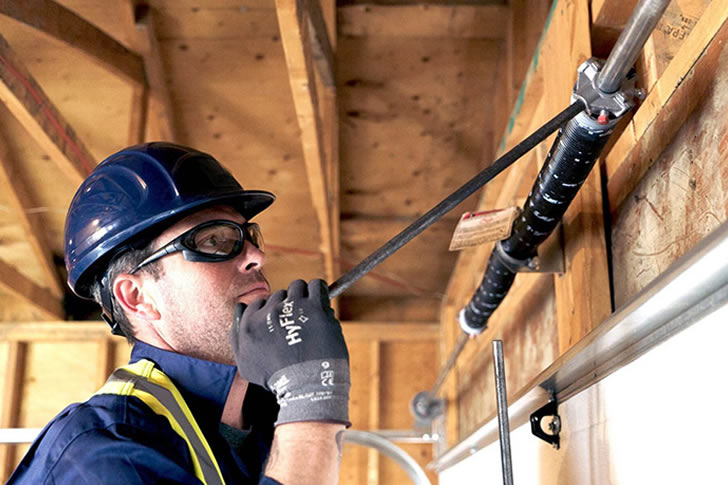Cost-Effective Solutions for Garage Spring Replacement
The springs play a crucial role in balancing and facilitating the smooth movement of the garage door. When one breaks, it’s essential to get it replaced promptly. This guide will outline how to safely and affordably replace your garage door spring without overspending.

Understanding Garage Door Springs: Before diving into the replacement process, it’s important to understand the two types of garage door springs: torsion springs and extension springs. Torsion springs are mounted on a stationary metal shaft located above and parallel to the top of the garage door frame. Extension springs are located above the horizontal tracks on both sides of the garage door. Knowing which type your garage door uses is crucial as it affects the cost and approach to replacement.
Step 1: Assess the Situation First, determine whether the spring really needs replacement. Signs of a broken spring include:
- The garage door won’t open or closes very quickly.
- You hear a loud bang from the garage.
- The door hangs at an angle.
- Springs appear stretched out or have a gap.
Step 2: Research the Costs Replacement costs can vary significantly based on the type of spring and the complexity of the job. Generally, torsion springs are more expensive than extension springs. Prices for the springs themselves might range from $30 to $100 each, but remember that the majority of the cost often comes from the service fee for installation.
Both torsion and extension springs come in various sizes, which correspond to the weight and size of the door they are designed to support. Typically, heavier or larger garage doors require larger springs, which can be more expensive.
Size Variations:
- Small Springs: Generally used for single-car garages with lighter doors. These can be on the lower end of the price spectrum, often ranging between $30 and $50 each.
- Medium Springs: Suitable for double-car garages or doors that are heavier than a standard single-car garage door. Prices for these springs typically range from $50 to $75.
- Large Springs: Designed for oversized or particularly heavy doors, these springs are the most costly, typically ranging from $75 to $100 or more, depending on specific requirements.
Impact of Size on Replacement Costs: The size of the spring directly affects the complexity of the installation. Larger springs, due to their size and the tension they must withstand, often require more time and specialized tools to install safely. This can increase the service fee portion of the total cost. A straightforward replacement of small springs might cost less in service fees, while larger springs could significantly increase the labor cost due to the additional effort and safety precautions needed.
By understanding these variations, homeowners can better anticipate the costs associated with their specific garage door spring replacement needs, ensuring they budget appropriately for both the springs themselves and the associated installation services.
Step 3: Get Multiple Quotes Don’t settle for the first estimate. Contact several garage repair services to compare prices. Be specific about the type of spring and the model of your garage door to get accurate estimates. This will also help you gauge the average cost and identify a reasonably priced service.
Step 4: Consider DIY Replacement If you are handy with tools and comfortable taking on mechanical projects, consider replacing the springs yourself. This can significantly reduce costs. However, be aware that replacing garage door springs can be dangerous due to the high tension in the springs. If you choose this route, ensure you:
- Purchase the correct springs.
- Follow all safety instructions.
- Use proper tools.
- Watch instructional videos or read detailed guides.
Step 5: Check for Warranties and Deals Sometimes, the original installation of your garage door or the springs themselves may come with a warranty that covers spring replacements. Check if you are still within the warranty period and what it covers. Additionally, look for deals or promotions from local garage door repair companies.
Step 6: Evaluate the Quality While it’s tempting to go for the cheapest option, consider the longevity and durability of the springs. Opt for high-quality springs that might cost a bit more upfront but offer better value over time due to their longer lifespan.
Step 7: Schedule Wisely Scheduling your replacement during off-peak seasons or times when business is slower might get you a discount. Ask about off-peak rates when you request quotes.
Conclusion: Replacing a garage door spring doesn’t have to be prohibitively expensive. With a bit of research, multiple quotes, and careful consideration of DIY options, you can manage the costs effectively. Always prioritize safety, whether you decide to hire a professional or do it yourself, and ensure that the job is done correctly to avoid further issues with your garage door.
Additional Tips:
- Regularly lubricate the springs with silicone-based lubricant to extend their life.
- Inspect your garage door periodically for signs of wear and tear.
- Educate yourself about basic garage door maintenance to prevent future problems.
By following these steps and tips, you can ensure a smooth and cost-effective replacement of your garage door springs, keeping your garage door running safely and efficiently.







Recent Comments